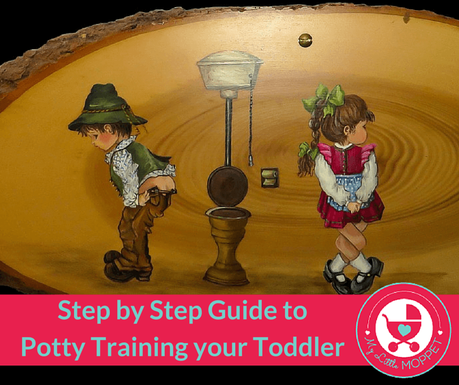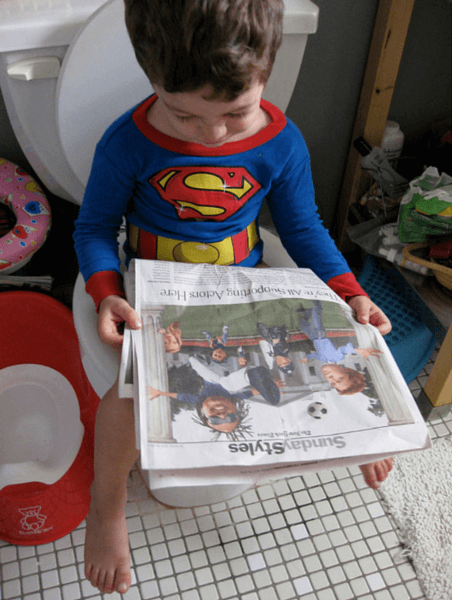In our previous posts, we talked about when to start potty training your child and how to introduce your child to potty training along with a collection of potty books for toddlers. Once you and your toddler have been sufficiently introduced to the potty training process, it's time to roll up your sleeves and get down to the actual training! Here is a step by step guide to potty training your toddler - broken down into easy, doable actions.

1. By now your child is already familiar with her potty and probably plays with it too! Now let her sit on it, fully clothed. Let her get used to the posture and how the potty feels under her bottom. Once she's got that down pat, move to the next step.
2. It's time to bring clothes into the picture. Make sure that for the next several weeks, you have clothes that are easy for your child to pull down and up by herself. This is important since too many buttons and strings can frustrate a child and is discouraging to the potty training process. Teach her this basic sequence - pull down pants -> sit on potty -> get up and pull pants back up. Do this several times till she doesn't require reminding.
3. If you're using a potty seat that is placed on a potty, let your child get used to climbing on the stool and sitting on it. In case your child seems scared to sit at such a height or is worried about falling in, don't force her. Instead get her a regular potty and you can make the transition to the toilet later.

4. Plan to be consistent. Keep the potty at the same place and practice there every day, so that your child isn't confused. Also, be sure to use the same words always. For instance, if you're saying 'pee-pee' and 'poo-poo', don't use different terms - this makes it easier for your child to communicate her toilet needs to you.
5. Once your child is comfortable with managing her clothes and sitting on the potty, introduce the cleaning routine - flush, clean bum, wash and dry hands. Do this every time she sits on the potty, regardless of whether she has actually used it or not. The cleaning routine is a crucial part of the potty training process and should become an automatic follow up to sitting on the potty. Make sure everything (soap, towel) is easily accessible to your child.

6. Now that your child is familiar with the routines and remembers the basic steps, you can start actually using the potty. Most kids pee soon after waking up and shortly after a breast feed or large drink, so these are good times to put her on the potty. Also take her to the potty before going outdoors, before and after naps, before bed and at regular intervals through the day. She's likely to pee on at least a couple of occasions, in which case don't forget to praise her so she understands that this is what's expected. Try not to interrupt the child when she's very involved in something - this will create negative associations with the potty. Work her toilet breaks around her routine and not the other way around.

7. As for bowel movements, most kids have a distinct form of elimination communication, also known as 'poopy face'! Knowing this makes life very easy, since you can guide your kids to the potty when you notice the signs. Doing this every day will make your kids automatically associate the potty with the feeling of when they're about to have a bowel movement. Some kids have pretty regular times, an hour after waking up or after a full meal; in such cases, be sure to have them near the potty.
8. Don't let your child strain too long on the potty; if she doesn't want to go now, it's fine. Let them follow through with the cleaning routine though. Make the time they're on the potty fun - don't leave them alone, and have a special potty book at hand that is reserved for potty moments.

9. In the initial days of potty training, there are bound to be many accidents. Your child might tell you after she's soiled her clothes, she might reach the potty too late or there may be some misdirection even in the potty (particularly for boys). In any case, stay completely calm and reassure your child; she's likely to be disappointed too, especially if she did make an attempt to reach the potty in time. Dump the gunk into the toilet, and follow through with the cleaning routine as usual. Let the child help in putting her dirty clothes in the bucket/laundry so she is involved in the complete process.
10. Stock up bathroom with enough toilet paper, dry towels, extra underpants and even extra shorts/pants. Make sure all the things required by the child are easily accessible and on low shelves and in child-safe containers. If possible use sparkly/colorful washing soap and towels in her favorite character/color.

At the end of the day, there are three most important points for parents to remember - never force your child, be consistent with all aspects of training and expect many accidents! For the initial stage of potty training, try to avoid planning any outings or events at home, and try to be with your child as much as you can. Put away all your expensive rugs and carpets and stock up on cleaning supplies. Please keep in mind that these steps are only for daytime training; night time training will come much later - watch out for our next post to know more!
Potty training is different for every child, and it's impossible to set a timeline for when you expect your child to be completely toilet trained. Don't listen too much to others as well; you'll only end up with unrealistic expectations which'll make both you and your child miserable! Stay calm, stay consistent and with our step by step guide to potty training, you'll soon see positive results!
